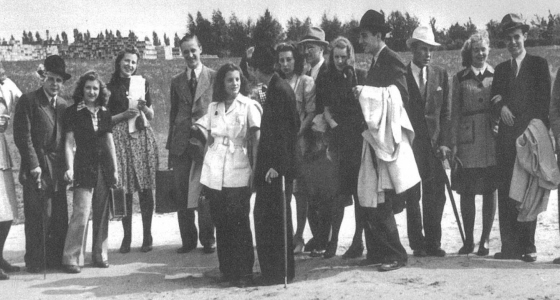
© Words - Katy Goebel
The youth of the western world was celebrating the end of global economic depression and the approach of modern times during the 1930s and 40s with a riotous explosion of dance and music called Swing. However, in Germany a repressive fascist regime under Adolf Hitler tried to impose its iron will on the German people, and keep them isolated from any international movements that threatened to undermine Nazi philosophy.
Contemporary Nazi Reports and Measures regarding German Swing Youth.
The Nazi authorities considered the dance craze of the Swing scene a particular menace. Swing was viewed as a very dangerous foreign import, because it was rooted in immoral Black ”jungle music” with accompanying allusions to wild, indiscriminate sex. Even worse, as far as the Nazi officials were concerned, Swing was a deliberate product of Jewish media moguls in America that, if spread to Germany, could contaminate the blood of its own youth. Youngsters caught up in a possible invasion of Swing would revert to more primitive forms of African-inspired behavior. Their blood would become contaminated as they bred babies of uncertain parentage as a result of sexual relations with multiple partners The Nazis were horrified as they imagined the prospects. Like the white bigots of 1960-era America boasted on radio shows while smashing records over desktops, “Rock & Roll has got to Go!” Only in Nazi Germany, Hitler and his henchmen were determined that Swing would never arrive.
To Hitler, the answer to the international menace of Swing was simple and straightforward: The National Socialist Party system of military and paramilitary organizations would exert total control over German youngsters, and physically keep them from straying off the narrow Nazi pathway.
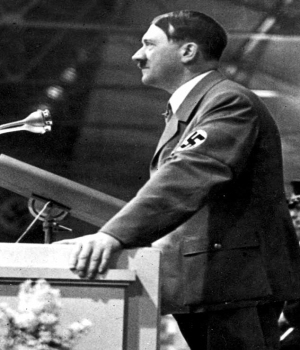 Hitler announced the draconian methods he would use to stifle youthful interest in non-German ways:
Hitler announced the draconian methods he would use to stifle youthful interest in non-German ways: “(...) Our Youth must learn nothing else, but only to think like and act like Germans! We must get our boys into a Party organization at the age of 10, where they can be immersed for the very first time in the totality of pure German spirit. Then, after four years, they will be transferred from this Young Folk (Jungvolk) into the Hitler Youth (Hitlerjugend). There we will keep them for another four years. One thing for certain, we will never surrender them back into the clutches of the enemies of our German State. Instead, we will immediately place them into our Party! Following this, we will put our young men into the ranks of the mandatory Labor Front (Arbeitsfront), the Stormtroopers (SA), the Party Guards (SS), the Motorized Party Unit (NSKK) and so on. Then, after they have been members of these organizations for up to two years but failed to become true National Socialists, we will reprocess them back through the mandatory Labor Front for another half-year of curative treatment. Everything will be united under one symbol, the German Spade of the Workers! And, if they still retain smudges of class consciousness or aloofness from Germandom, then the Armed Forces (Wehrmacht) will deal with them for another two years. Furthermore, if they return after two, three, or even four years, we will immediately put them back into the ranks of the SS, SA or other fit organizations in order to protect them from the slightest relapse from German Will. In this manner, they will not live freely apart from the service of Germany for their entire lives!"
Excerpt of Hitler’s speech at Reichenberg, December 2, 1938.
The National Socialist solution to the problem, imposed by some of the most militant “control freaks” in world history, was apparently less than a total success. Later, at the height of the war in early 1944, the Reich Ministry of Justice lamented:
“(...)One of the most striking appearances among dangerous groups within the Reich is the so-called Swing Youth. They are reported to exist in many different parts of the country….These cliques begin their activities out of a selfish impulse to amuse themselves, but rapidly deteriorate into anti-social criminal gangs. Even before the war, boys and girls from the elite social set in Hamburg would get together dressed in notorious baggy or loose clothing and become entranced under the spell of English music and English dance. The Flottbecker Clique (Swing Kids from Hamburg) organized private dance parties attended by 500-600 teenagers during the winter of 1939-40. These lewd affairs included unrestrained Swing dancing. The Authorities rightfully banned such house dances, but the cliques were addicted to the English beat and continued to organize unlawful jamborees full of sexual mischief. The enormous cost of this illicit lifestyle was met by criminal resort to petty theft and music store burglaries. Needless to say, their penchant for the extravagant and self-centered wild life at clubs, bars, cafes and house gatherings comes at the expense of their support for our gallant war effort. They do not appreciate the success of our forces in the field, and even disparage the ultimate sacrifice of our men in uniform. What follows next is the inevitable and clearly discernable hostility toward any military service of their own. Clique members show off by dressing audaciously in British-style clothing. They often wear jackets cut in the Scot slit manner, carry umbrellas, and put fancy-colored collar-studs in their jacket lapels as badges of their arrogance. They mimic the decadent English way of life, because they worship the Englishman as the highest evolutionary development of mankind. Their mistaken ideals of individual freedom (which, in Nazi opinion countered true German freedom to help the greater community by ridding it of pestilence and Jews) leads them to openly oppose the Hitler Youth. One example of these Swing Cliques was a Harlem Club in Frankfurt that held extremely offensive house parties. These Harlem Club parties were frequented by very young and impressionable girls who were seduced into freely participating in random intercourse. The drunken free-sex affairs were typified by alcoholic excesses and dance orgies where teenagers “swung” and got “hot”. Because of evacuation methods necessitated by wartime conditions, these cliques have now been scattered from their rooting grounds.”
Excerpt from Reichsjustizministerium Report, early 1944
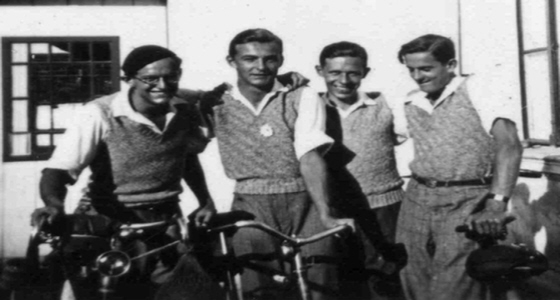
The German Swing Youth members are commonly called Swing Kids. Nazi authorities documented distinctive features of the Swing Kids in order to suppress them. Official reports stated that Swing Kids could be easily identified by their striking appearance and outlandish clothing, compared to other Germans of their own age. These traits included several facets.
One of the most prominent hallmarks of the Swing Kids were their flagrant haircuts, which became almost mandatory among their members. Of course, individual styling of one’s hair has often marked youth rebelliousness, as demonstrated in more recent times by hippies or punk rockers. This was also true in Nazi Germany and not limited to the Swing Kids. Several informal youth groups at odds with the Authorities used their hair to “make a statement”. For instance, the hikers of the Edelweiss Pirates (Eidelweisspiraten) sported unique hair styles.
The differences between American and German hairstyles for youth interested in Swing was probably very slight. This is because German movies featured stars and starlets who wore their hair in very modern fashion of the times, almost in complete harmony with those of Hollywood actors. The German Swing Kids copied the hairstyles of their favorite movie idols, and were therefore very up-to-date with the latest trends.
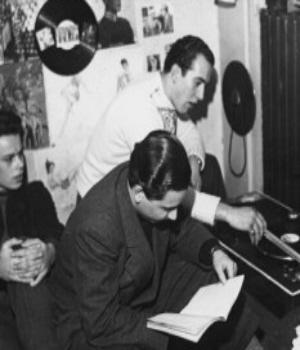 Male Swing Kids rebelled against the short military haircuts of other boys by growing “whips” of long hair, sometimes over a foot in length from their foreheads, that were combed backward with Brillantine or sugared water. Female Swing Kids openly violated the traditional, braided hairstyles approved for girls by letting their hair grow long and loose, and by sometimes inserting permanent waves with chemicals and curlers. This artificially-treated hair done up in foreign fashion was an anathema to Nazis, who disdained any deviance from the officially-approved girlish look deemed appropriate for “nice German girls”.
Male Swing Kids rebelled against the short military haircuts of other boys by growing “whips” of long hair, sometimes over a foot in length from their foreheads, that were combed backward with Brillantine or sugared water. Female Swing Kids openly violated the traditional, braided hairstyles approved for girls by letting their hair grow long and loose, and by sometimes inserting permanent waves with chemicals and curlers. This artificially-treated hair done up in foreign fashion was an anathema to Nazis, who disdained any deviance from the officially-approved girlish look deemed appropriate for “nice German girls”. Choosing the proper clothing to harmonize with foreign Swing trends was more problematic for the Swing Kids. Their inspiration came from rare American and English film clips and magazines, or already-known fashions of foreign vintage thought to be in harmony with Swing freedom. The German film industry, which was very sophisticated and enjoyed global recognition as a cutting-edge art form, provided excellent leads with both its movies and fan magazines. The film stars dressed and acted in the latest international fashion and their saucy, cool manners matched their idol status. The German Swing Kids imitated their film idols and acted accordingly, and in the process became pretty hep themselves.
The German movies portrayed a lifestyle completely different than that of militarized Germany, so that their atmosphere was one of relaxed peacetime and often luxurious living. The film industry shied away from films containing a lot of propaganda, because German audiences disliked them. The lack of propaganda in many movies made films more appealing to Swing Kids. In addition, movies offered one of the few escapes from the war, and movies refrained from wartime references in order to please audiences. Modern movie attitudes were inconsistent with ever-present Nazi propaganda methods, but necessary to attract ticket-buying moviegoers.
Male Swing Kids favored London/New York-style bulky double-breasted suit coats with very wide lapels, or bold-style “zootie” suit coats reaching almost to the knees, after the fashion of the “American Negro zoot suiters”. If possible, the coats were tailored to cut sharply in at the waist in “tough-guy” fashion reminiscent of Hollywood-fashion American gangsters. Their baggy, deep-rise trousers with turned-up cuffs, and ostentatious shoes with bright but strong crepe soles, matched this motif. The American look, however, was tempered with Anglophile favoritism toward carrying an almost-obligatory umbrella, aping English Foreign Secretary Anthony Eden. A foreign daily newspaper in the outer coat bag, as well as a Shag-pipe, topped off the “dead smart” look. Favoritism toward British ways was most typical of Hamburg, Germany’s largest port city, which for centuries enjoyed strong mercantile bonds with English seaports.
There was some variance between the attire of Swing Kids living in different cities. Within Hanover the Swing Kids preferred white or off-white overcoats (“dust coats”), pinstripe suits, and extremely wide-brimmed hats worn at a rakish angle. In Hamburg, on the other hand, several groups of Swing Kids wore dark-colored coats with white “Cachenez” trimming, suits having glen-check patterns, soft-felt Homburg hats in Lettow-Vorbeck style, and blue sporty shirts with bright white or yellow ties. Swing Kids of Frankfurt liked to dress in “zoot-suiter“ style, complete with zooter coats, trousers that narrowed close about the ankle (for fast getaways on bikes), and a long key chain suspended from the hip almost to the ground that was emblematic of zooties worldwide. Inside Berlin Swing Kids wore double-breasted baggy suits with ties or flies underneath a variety of overcoats that included civilian trenchcoats, camel-hair coats, and even “teddy bear” fur coats.
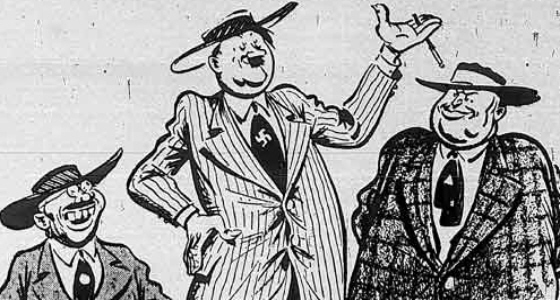
Female Swing Kids also appeared very different than their normally-clad counterparts in fascist German society. Foremost, they used makeup. Nazi officials were absolutely aghast at the use of cosmetics by women, especially young girls. Such products were considered Jewish artifices of the Hollywood culture, which ruined the natural purity of German beauty and invited sexual wantonness. The Swing Kid “chicks” defied this intolerance by sporting generously applied lipstick, even in outrageous colors like cyclamen purple. The brazen use of cosmetics extended even to dazzle-dust (face powder), dragged eyebrows and nail polish.
In America girls became fairly standardized in their apparel by 1940, so that one only needed a few sweaters, a skirt, saddle shoes and bobby sox. The best sweaters were made of angora and cashmere. In Germany female Swing Kids wore dresses, or skirts with blouses or knitted pullovers. Actual American-style sweaters were extremely rare, especially those of angora or cashmere. In Bavaria girls favored Dirndl dresses (a bodice-dress with full gathered skirt), which were also highly popular in the United States about 1938. Saddle shoes, however, did not exist in Germany.
The girls who belonged to the Swing movement dallied with almost any device that seemed to evoke Hollywood and “modern decadence”. They liked to strike sensual poses by using long cigarette-holders in the style of American movie stars. They deliberately purchased the most expensive dresses they could find, openly scoffing at government programs to conserve material and resources.
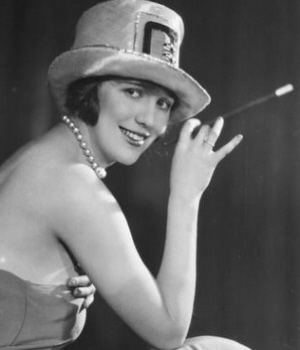 To understand the discontent that stirred Nazi disapproval of female “fashion excesses”, one must understand the National Socialist preference for standardization. Not only were cosmetics and smoking by girls disapproved (Hitler was a non-smoker), but individual fashion in general was discouraged. Aside from the obvious dislike of clothing that stimulated sexual desire, the Party believed that a lot of individual choice in clothing was another danger to uniformity within the State. For young girls, model attire and uniforms of the League of German Girls (JM/BDM or Jung Madel / Bund Deutscher Maedchen) was meant to embody the regulated order and disciplined obedience of otherwise intemperate female disposition. One is hard-pressed to explain many bizarre aspects of Nazi philosophy, except to point out that it was perhaps the ultimate male-dominated society. The public nudity of girls and sun worship by naked youngsters was openly encouraged, and it was permissible for a girl to exhibit her body in “natural German settings” completely unclothed to strangers. Yet it was a punishable offense to wear dresses that were deemed too short among friends.
To understand the discontent that stirred Nazi disapproval of female “fashion excesses”, one must understand the National Socialist preference for standardization. Not only were cosmetics and smoking by girls disapproved (Hitler was a non-smoker), but individual fashion in general was discouraged. Aside from the obvious dislike of clothing that stimulated sexual desire, the Party believed that a lot of individual choice in clothing was another danger to uniformity within the State. For young girls, model attire and uniforms of the League of German Girls (JM/BDM or Jung Madel / Bund Deutscher Maedchen) was meant to embody the regulated order and disciplined obedience of otherwise intemperate female disposition. One is hard-pressed to explain many bizarre aspects of Nazi philosophy, except to point out that it was perhaps the ultimate male-dominated society. The public nudity of girls and sun worship by naked youngsters was openly encouraged, and it was permissible for a girl to exhibit her body in “natural German settings” completely unclothed to strangers. Yet it was a punishable offense to wear dresses that were deemed too short among friends. Today, many German wartime publications provide us with valuable references to Swing Kid fashion. During 1939, the National Socialist Party newsmagazine for the Hamburg District, Hamburger Gaunachrichten, featured an outline caricature of a girl Swingateer dancing provocatively in a very revealing, short dress. Of course, the heart-stopping notion of this image might have inspired rather than discouraged some girls eager to attract boyfriends with their youthful beauty! One 1944 wartime thesis, by Hans-Herbert Krueger, describes the summertime girls of a Hamburg Swing Club as wearing white-rimmed sunglasses with unfeminine long pants. This same subject is repeated in another caricature of the Hamburger Gaunachrichten in October 1941.
Regardless of their attire, Little Misses in every country quickly learn how to sit and pose themselves to best advantage. Such flirtatious mannerisms were highly disliked by the Reich Youth Leadership (Reichsjugendfuehrung), which was set on preserving the “untouchable integrity” of German womanhood. The very sight of schoolgirls, in Swing-inspired dresses or mixed civilian-JM/BDM attire, smoking and flirting with stylish abandon, must have provided a final shock to many an older, stalwart Party diehard as the war dragged on to its unfavorable conclusion.
Both boys and girls who were Swing Kids had to search hard to create Swing-suitable wardrobes. Necessary clothing and accessories were difficult to find, even for those with money. For children from middle-class and working German families, such luxuries were impossible to obtain. Second-hand or discarded clothing and cheaper-quality goods provided one alternative. However, in general, Improvisation and talented creativity was the order of the day.
Swing Kids of the Vienna Shuffles (Wiener Schlurfs) employed a number of tricks to get the required results. An old hat could be molded to the desired shape by applying steam. Large single-breasted suits, if they were large enough, could be converted to double-breasted versions by adding additional buttons. Of course, petty theft provided a ready answer to getting anything that money couldn’t buy. However, this aspect of the Swing Kid culture is not often discussed, although any criminalization was minor compared to the master criminals of the Nazi Party busy slaughtering millions of Jews and destroying the entire nation in a vicious campaign aimed at world enslavement. But the truth that Swing Kids indulged in anti-societal behavior, such as thievery and perhaps thuggery, must not be overlooked in appraising their conduct as a resistance movement to the Reich regime.
The fashion of the Swing Kids made them easily visible to everyone, and by itself was a indication of considerable courage. These rebels openly celebrated their differences from mainstream Germanic society. Within the German Swing Youth movement itself, the individual clubs also distinguished between themselves by wearing handmade identity badges. These included all sorts of small pins. Some clubs wore collar-studs stuck under and over coat lapels. The Harlem Club of Frankfurt had rectangular devices tipped with white metal rimmed in blue. The Wilhelmsburg and Eimsbuettel neighborhood clubs of Hamburg displayed lapel badges made from converted German pennies.
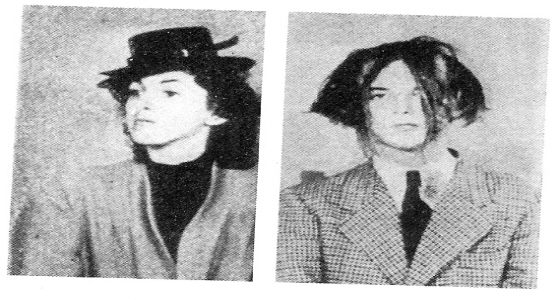
Music and Dance of the German Swing Youth :
The Swing Kids loved English and American Swing music and jitterbugging as much as they loved Swing-style fashions. This was all part of their yearning for liberated American ideals and riches, which appeared doubly attractive compared to the suffocating repression of personal freedom and austerity within Nazi Germany.
The most fundamental prerequisite for being a real Swing Kid was owning or having access to the latest shellac Swing records. Unlike America, there were no jukeboxes that could blare out Swing music sweet and clear. But a few lucky individuals had gramophones, although the speakers of such portable record-players produced comparatively dismal sound. Entire clubs formed around a single gramophone owner. Once the turntable and records were available, the Swing Kids were free to swarm for their favorite jazz musicians like Teddy Stauffer, Nat Gonella and Louis Armstrong. In the capital of Berlin, possession of Armstrong’s records Tiger Rag and Saint Louis Blues was a must.
The Swing Kids also listened to Swing music over foreign-broadcast channels like BBC on their home radios. This alternative became more important as the war dragged on, and sources for actual jazz and Swing records dried up. Although it was prohibited by the Nazi Government, the resourceful Swing Kids recorded music from the radio and then cleverly pressed the recordings on audio-sound devices (tonfolien), which could be sold undercover at school. However, the Swing Kids were never content to merely listen to the radio and a few records. They formed their own bands by rustling together the necessary instruments, such as a clarinet, a sax, a trumpet, trombone, drums and a piano.
Dance was the ultimate experience. The best thing about being a Swing Kid was the opportunity to Swing and jitterbug to a fast tempo. The youngsters were free to “break down”, and blow off excess teenage energy, being limited only by their own individuality and pace of spontaneity. The highly charged atmosphere of Swing-dance events became almost hypnotic as young boys and girls swirled about to dizzy, physically exhausting dance numbers. Their compatriots in the Hitler Youth, used to the grace and dignity of authorized dance routines, were left dumbstruck by the scene:
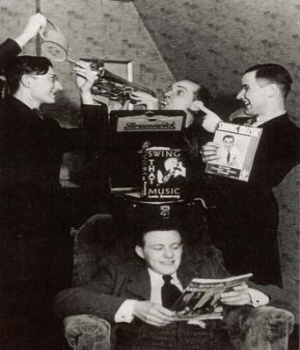 “The sight of some three hundred dancing people thrashing about was absolutely horrid. No one can describe the dancing because no one danced normally. Indeed, this was the naughtiest of Swing dancing that can be imagined. Sometimes two boys danced with one juvenile girl, and at other times several couples locked themselves into a mass embrace and just hopped around. Many couples hopped together while holding hands and bent over wildly, so that their long hair flew across their faces and whipped their thighs as they spun. You had to worry about the sanity of some of them. The scenes that happened on the dance floor were fit for a lunatic asylum. Even the most hysterical and primitive Black jungle warrior war-dance would have paled in comparison to what happened here. Everyone jumped about like crazy while they mumbled English musical gibberish. The Band increased the tempo faster by the minute. No member of the band was sitting, because they were all getting hotter and wilder as they also succumbed to the jungle beat on the stage. You often saw boys dancing together with other boys, always with two cigarettes dangling from each corner of the mouth.”
“The sight of some three hundred dancing people thrashing about was absolutely horrid. No one can describe the dancing because no one danced normally. Indeed, this was the naughtiest of Swing dancing that can be imagined. Sometimes two boys danced with one juvenile girl, and at other times several couples locked themselves into a mass embrace and just hopped around. Many couples hopped together while holding hands and bent over wildly, so that their long hair flew across their faces and whipped their thighs as they spun. You had to worry about the sanity of some of them. The scenes that happened on the dance floor were fit for a lunatic asylum. Even the most hysterical and primitive Black jungle warrior war-dance would have paled in comparison to what happened here. Everyone jumped about like crazy while they mumbled English musical gibberish. The Band increased the tempo faster by the minute. No member of the band was sitting, because they were all getting hotter and wilder as they also succumbed to the jungle beat on the stage. You often saw boys dancing together with other boys, always with two cigarettes dangling from each corner of the mouth.” Hitlerjugend Patrol Report on a Hamburg Swing Dance, August 2, 1940.
As this Hitler Youth report reveals, the German officials could not comprehend this type of dancing. In their minds, dancing was supposed to be a refined series of dance steps obediently executed with precision and charm. Swing, with its unrestrained zeal and lust for physical exertion, seemed to be either a manifestation of serious mental illness or downright primitive Negroid hysteria. In any case, Swing was decidedly anti-German. The Swing Kids tore down all conventions of approved dance, and behaved with undisciplined sexual indecency, which even included same-partner coupling. The latent or open homosexuality, the promiscuous sexual conduct between boys and girls, and the total lack of restraint was simply impermissible to Nazi doctrine. The National Socialist authorities felt compelled to crack down hard against all discoverable Swing dance events.
In the meantime the Swing Kids increased their anti-conventional dancing style, by adding unique gestures to their defiant version of Swing. One dance gesture involved swinging an arm up in a sluggish fashion while lifting a forefinger to the rhythm, in a motion meant to imitate Black performers. Far more serious was the open disrespect of the German National Greeting (Hitler Salute) that Swing Kids ridiculed with another dance gesture. While dancing, they would outstretch their arm in a typical Sieg Heil, but separated their fingers in a V after Churchill’s famous Victory sign. Mockery of the German National Greeting was a serious breach of German law, but the Swing Kids openly flaunted it. A 1941 edition of the Hamburger Gaunachrichten has a picture of a Swing Kid in the very act.
National Socialist literature warned of the dire consequences for the Reich if the world witnessed such gestures:
“A foreign Jewish newspaper once admitted, while cynically reviewing the 1937 Reich Party Convention (Reichsparteitag), that the Nuremberg parades gave convincing evidence that democracy has been eliminated in Germany. However, the newspaper noted the fact that German youth was still dancing to jazz, and so jazz might provide a round-about way to pry Germany open again to democratic incursion by anti-German forces. We decline a philosophy of life based on how a population dances. But this shows that there is still a lot for us to do, in the revolution of private life, in order to completely Germanize our people.” %
National Socialist magazine SA-Mann, 1938
In the end, however, the task of completely Germanizing the population, by ridding it of foreign influences, failed. The task was beyond the ability of the entire National Socialist Party acting with the full weight of the militant State Apparatus. The Germans remained part of the world community, because of a simple phenomenon. Some brave German youngsters wanted to enjoy the individual liberty to Swing. The Swing Kids desired to dance in the open. But they continued to swing, even if it had to be conducted in the secrecy of their private rooms or in underground bunkers. They were active until the very end of the war. Now Swing, once confined to a rebellious handful, has experienced a great boom in popularity once again.
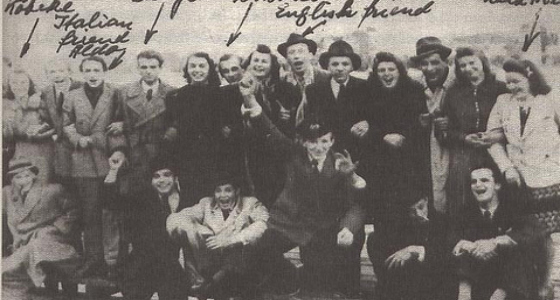
Original article appeared in www.swingstyle.de. – Used by kind permission
Part Two Here





